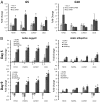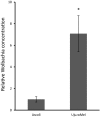Wolbachia strain wMel induces cytoplasmic incompatibility and blocks dengue transmission in Aedes albopictus
- PMID: 22123944
- PMCID: PMC3252941
- DOI: 10.1073/pnas.1112021108
Wolbachia strain wMel induces cytoplasmic incompatibility and blocks dengue transmission in Aedes albopictus
Abstract
Wolbachia inherited bacteria are able to invade insect populations using cytoplasmic incompatibility and provide new strategies for controlling mosquito-borne tropical diseases, such as dengue. The overreplicating wMelPop strain was recently shown to strongly inhibit the replication of dengue virus when introduced into Aedes aegypti mosquitoes, as well as to stimulate chronic immune up-regulation. Here we show that stable introduction of the wMel strain of Drosophila melanogaster into Aedes albopictus, a vector of dengue and other arboviruses, abolished the transmission capacity of dengue virus-challenged mosquitoes. Immune up-regulation was observed in the transinfected line, but at a much lower level than that previously found for transinfected Ae. aegypti. Transient infection experiments suggest that this difference is related to Ae. albopictus immunotolerance of Wolbachia, rather than to the Wolbachia strain used. This study provides an example of strong pathogen inhibition in a naturally Wolbachia-infected mosquito species, demonstrating that this inhibition is not limited to naturally naïve species, and suggests that the Wolbachia strain is more important than host background for viral inhibition. Complete bidirectional cytoplasmic incompatibility was observed with WT strains infected with the naturally occurring Ae. albopictus Wolbachia, and this provides a mechanism for introducing wMel into natural populations of this species.
Conflict of interest statement
The authors declare no conflict of interest.
Figures




Similar articles
-
The wMel Wolbachia strain blocks dengue and invades caged Aedes aegypti populations.Nature. 2011 Aug 24;476(7361):450-3. doi: 10.1038/nature10355. Nature. 2011. PMID: 21866159
-
Novel Wolbachia-transinfected Aedes aegypti mosquitoes possess diverse fitness and vector competence phenotypes.PLoS Pathog. 2017 Dec 7;13(12):e1006751. doi: 10.1371/journal.ppat.1006751. eCollection 2017 Dec. PLoS Pathog. 2017. PMID: 29216317 Free PMC article.
-
A Wolbachia wMel transinfection in Aedes albopictus is not detrimental to host fitness and inhibits Chikungunya virus.PLoS Negl Trop Dis. 2013;7(3):e2152. doi: 10.1371/journal.pntd.0002152. Epub 2013 Mar 28. PLoS Negl Trop Dis. 2013. PMID: 23556030 Free PMC article.
-
A comprehensive review of Wolbachia-mediated mechanisms to control dengue virus transmission in Aedes aegypti through innate immune pathways.Front Immunol. 2024 Aug 8;15:1434003. doi: 10.3389/fimmu.2024.1434003. eCollection 2024. Front Immunol. 2024. PMID: 39176079 Free PMC article. Review.
-
The Use of Wolbachia by the World Mosquito Program to Interrupt Transmission of Aedes aegypti Transmitted Viruses.Adv Exp Med Biol. 2018;1062:355-360. doi: 10.1007/978-981-10-8727-1_24. Adv Exp Med Biol. 2018. PMID: 29845544 Review.
Cited by
-
Wolbachia infections in natural Anopheles populations affect egg laying and negatively correlate with Plasmodium development.Nat Commun. 2016 May 31;7:11772. doi: 10.1038/ncomms11772. Nat Commun. 2016. PMID: 27243367 Free PMC article.
-
New Insights into Cockroach Control: Using Functional Diversity of Blattella germanica Symbionts.Insects. 2020 Oct 13;11(10):696. doi: 10.3390/insects11100696. Insects. 2020. PMID: 33066069 Free PMC article. Review.
-
wFlu: characterization and evaluation of a native Wolbachia from the mosquito Aedes fluviatilis as a potential vector control agent.PLoS One. 2013;8(3):e59619. doi: 10.1371/journal.pone.0059619. Epub 2013 Mar 26. PLoS One. 2013. PMID: 23555728 Free PMC article.
-
Microbial symbiosis and the control of vector-borne pathogens in tsetse flies, human lice, and triatomine bugs.Pathog Glob Health. 2013 Sep;107(6):285-92. doi: 10.1179/2047773213Y.0000000109. Pathog Glob Health. 2013. PMID: 24188239 Free PMC article. Review.
-
Culex pipiens and Culex restuans mosquitoes harbor distinct microbiota dominated by few bacterial taxa.Parasit Vectors. 2016 Jan 13;9:18. doi: 10.1186/s13071-016-1299-6. Parasit Vectors. 2016. PMID: 26762514 Free PMC article.
References
-
- Gratz NG. Critical review of the vector status of Aedes albopictus. Med Vet Entomol. 2004;18:215–227. - PubMed
-
- Sinkins SP, Braig HR, O'Neill SL. Wolbachia superinfections and the expression of cytoplasmic incompatibility. Proc Biol Sci. 1995;261:325–330. - PubMed
-
- McMeniman CJ, et al. Stable introduction of a life-shortening Wolbachia infection into the mosquito Aedes aegypti. Science. 2009;323:141–144. - PubMed
-
- Moreira LA, et al. A Wolbachia symbiont in Aedes aegypti limits infection with dengue, Chikungunya, and Plasmodium. Cell. 2009;139:1268–1278. - PubMed
Publication types
MeSH terms
Grants and funding
LinkOut - more resources
Full Text Sources
Other Literature Sources
Medical

